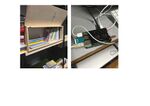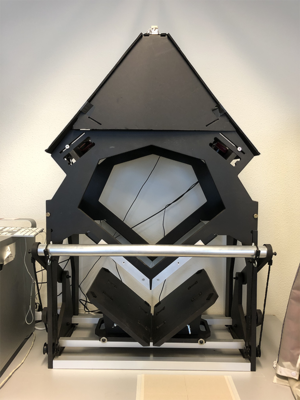User talk:Simon/Digitising Printing: Difference between revisions
(Created page with "File:the physical digital bl.jpeg|150px|thumb|The physical bootleg library contained in a disused champagne crate, and the digital bootleg library running from a Raspberry P...") |
No edit summary |
||
| (3 intermediate revisions by the same user not shown) | |||
| Line 1: | Line 1: | ||
[[File:the physical digital bl.jpeg|150px|thumb|The physical bootleg library contained in a disused champagne crate, and the digital bootleg library running from a Raspberry Pi computer]] | [[File:the physical digital bl.jpeg|150px|thumb|The physical bootleg library contained in a disused champagne crate, and the digital bootleg library running from a Raspberry Pi computer]] | ||
{{User:Simon/Trim4/Text Laundrette}} | {{User:Simon/Trim4/Text Laundrette}} | ||
{{User:Simon/Feminist_Art_Manifestos}} | |||
[[Category: Library Snippets]] | [[Category: Library Snippets]] | ||
Latest revision as of 14:09, 20 June 2020
Text Laundrette
Text Laundrette is a workshop in which we use a home-made, DIY book scanner, and open-source software to scan, process, and add digital features to printed texts brought by the participants to the workshop. These are included in the “bootleg library”, a shadow library accessible over a local network. The workshop was organised by Simon Browne and Pedro Sá Couto, for the 2020 py.rate.chnic sessions and first held at WdKA in the Publication Station, February 2020.
Description
Text Laundrette is a print party workshop.
We will use a home-made, DIY book scanner, and open-source software to scan, process, and add digital features to printed texts brought by the participants to the workshop. Ultimately, we will include them in the "bootleg library", a shadow library accessible over a local network.
Shadow libraries operate outside of legal copyright frameworks, in response to decreased open access to knowledge. This workshop aims to extend our research on libraries, their sociability, and methods by which we can add provenance to texts included in public or private, legal or extra-legal collections.
At WdKA Publication Station
The workshop follows a workflow of the following steps:
- Choosing texts
- Watermarking
- Scanning
- Processing
- Uploading
- Rinse and repeat (return to step 1)
First workshop 03.02.20
The workshop ran over 2 hours with invited guests from the academy. It was an ambitious workflow, but we managed to run through several iterations of watermarking, scanning, processing and uploading. The realisation of how much work is involved in digitising and processing texts was certainly a take-home for participants. An interesting moment occurred when uploading - who was the author of the altered text?
Some photos here:
bootleg book: Feminist Art Manifestos
First edition
Printed: 12.09.19
Dimensions: 130x180mm
Cover stock: Clairefontaine Trophee (green) 210gsm
Text stock: Bio Top 80gsm
Binding: Perfect bound (hot glue)
Pages: 180pp
This book took quite some time to lay out. The original publication exists as an EPUB. You have to buy it, and it's not available in this format from the usual pirate libraries, but I did find an HTML version on https://monoskop.org/media/text/feminist_art_manifestos/
I ran pandoc on the HTML file to turn it into a .rtf so that I could lay it out in InDesign using this command:
$ pandoc -s source.html -o new_source.rtf
This retained italics and hyperlinks (which was super nice), but there were lots of line-breaks that I didn't need and had to remove manually as find/change in InDesign is indiscriminate...
In some ways the digital book is superior to the printed version as you can click on the hyperlinks to visit the source pages of many of these texts, something which is obviously impossible in the printed version, although it does say where the manifestos can be found.
The interesting thing about doing this as a book sprint is the speed at which you have to make design decisions. This makes the design quite minimal, and the only typographic conceit here was with a decision to use a variety of indentation styles, which refers to the multiplicity of feminist manifestos. The interesting thing for me about these texts is that they show many different artistic views of feminism which don't necessarily agree with each other.
During the time I was laying out this publication, I was invited by Artemis to join her and Paloma in applying to present our Marginal Conversations workshop in Athens at the ETC (Eclectic Tech Conference) festival. We were all pretty excited about the prospect, however as it turned out, some of the organisers were unsure about me presenting a workshop as a cis-gendered hetero man. Although I was disappointed, I understood the reasoning, as due to the nature of this particular conference (which started as a way for women and queer, trans & non-binary folk to share skills outside of a patriarchal male-dominated tech culture. I was reassured that this was not the opinion of all of the organisers, but of some, however, they were trying to reach a compromise with me and each other. I found this an interesting sidenote to the publication I was producing, in which there is a plurality of views that co-exist.
Second edition
Printed: 05.03.20
Dimensions: 130x180mm
Cover stock: Clairefontaine Trophee (grey) 210gsm
Text stock: Laser 80gsm
Binding: Perfect bound (hot glue)
Pages: 224pp
I decided to print a second edition of this book for two reasons; 1) someone had borrowed the first edition three months ago and it hadn't been returned, and 2) what's a books of Feminist Art Manifestos without any images?
I spent quite some time tracking down images to use in the book. Oftentimes I couldn't find an image that directly corresponded to the writer/writers of each manifesto, which created an interesting opportunity to think about who is represented by each text. Sometimes it was an image of an artwork (if the manifesto was written by an artist), sometimes an image of a collective or the publications they produces, often a portrait of the author or authors, sometimes an image of the manifesto as it appeared in print originally. Each manifesto text is prefaced by an image - abutting the text of a previous manifesto. This creates an interesting connection between seemingly disparate elements and waves of feminist movements. The book was printed in the same size as the first edition, with a grey cover, and noticeably more pages due to the addition of so many colour images.





























